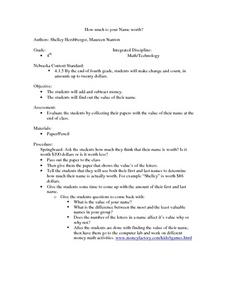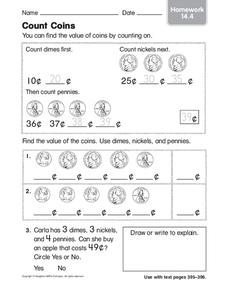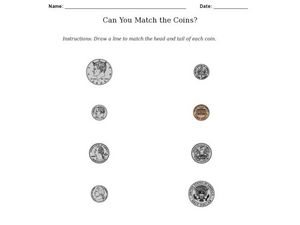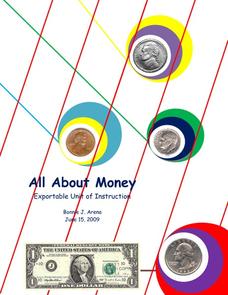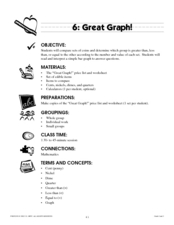Curated OER
Let's Learn About Money
In this money learning exercise, students count the coins in 12 different boxes. Students write the total amount of each collection of coins on the lines provided.
Curated OER
Counting Coins to 50 Cents
In this counting coins instructional activity, students solve 20 problems in which dimes and nickels and pennies are counted and the total calculated. All totals are under 50 cents.
Curated OER
What's in Your Piggy Bank?
Fill up your piggy banks! First graders find different ways to fill up cute piggy banks with 30 cents. Will they use two dimes and two nickels? Or a quarter and five pennies? Use this activity with groups to reinforce your money math...
Curated OER
Money
In this counting change learning exercise, students look at 7 rows of various coins and then add up each row of coins. Students put their total amounts on the lines at the end of each row.
Curated OER
Mixing Coins
Young scholars explore mixed (different denomination) coin sets and create different total amounts.
Curated OER
How Much is Your Name Worth?
Students identify the value of each coin type and then use a code to assign each letter of the alphabet to the value of the coins. They add coin combinations to determine the value of their name.
Curated OER
Coin Cards
In this U.S. coins worksheet, students cut apart 16 cards that feature photographs of the front and back of quarters, nickels, dimes and pennies. There are no directions.
Curated OER
Coin Combos
In this combination of coins worksheet, students make the specified amount using the number of coins indicated. Example: Make 35 cents with 2 coins. (1 quarter, 1 dime).
Curated OER
Value of Money
Second graders examine a collection of coins to discover their value. For this value of money lesson, 2nd graders identify the amount of money represented by each coin. Students use a worksheet to complete story problems involving...
Curated OER
Making $ents
Second graders complete several activities that give them opportunities to practice and model strategies that help them count money. They read The Penny Pot storybook; they play a trading game with various coins. They participate in a...
Curated OER
Math/Technology: Coin Combos
Second graders identify coin combinations needed to purchase items under a dollar. Using Kidspiration, they demonstrate three ways to purchase a pizza slice for 96 cents and choose an item which cost less than a dollar for other to...
Curated OER
Dimes, Nickels, and Pennies
In this math literacy worksheet, learners are shown coins in picture form for 10 problems and are expected to figure the amount of money for each.
Curated OER
Learn to Earn When You Tend to Spend
Young scholars examine spending and earning, and calculate change up to a dollar. They view and participate in demonstrations of earning and spending math problems, complete a worksheet, and play a game in pairs that simulates banking.
Curated OER
Count Dimes, Nickels and Pennies
In this coin counting worksheet, students count sets of coins, writing totals beside each, then do the same for problems written in words.
Curated OER
Count Coins
In this counting coins worksheet, learners find the value of given sets of coins. Coins used are dimes, nickels and pennies. Then, students answer an additional word problem related to money.
Curated OER
What Can I Buy?
In this counting coins review worksheet, students examine 4 price tags in order to record the number of nickels and dimes needed to buy the item. Students also respond to 1 short answer question.
Curated OER
Money: Demonstrating Coin Value up to $1.00
Students examine coin values up to $1.00 using paper coins. In this coin value activity, students compare and contrast various coins to aid in identification, sort coins from smallest to largest, and match an equal number of pennies to...
Curated OER
Money Sense
Students identify the value of quarters, dimes, nickels, and pennies, and use a variety of coins to show the value of a dollar. They count the exact amount of purchase.
Curated OER
Can You Match the Coins?
In this early childhood identifying coins worksheet, students match the heads of the 5 coins to tails of the coins. A dime, half-dollar, quarter, penny, and nickel are included
Curated OER
Count the Change
In this counting money worksheet, students study the coins in each set that includes quarters, dimes, nickels, and pennies. Students write the total amount for each box.
Curated OER
Math Challenge
In this money worksheet, 2nd graders count coins. Students study quarters, dimes, nickels and pennies and write the amount show for 6 problems.
Curated OER
All About Money
Few topics engage young mathematicians as much as learning about money. Through a series of shared readings and hands-on activities, children explore the US currency system, learning how to count money and calculate change as they create...
Curated OER
Great Graph!
Here is a fantastic lesson counting coins, interpreting graphs, and the concept of "greater than" and "less than." Young mathematicians utilize worksheets embedded in the plan in order to practice these concepts. The worksheets are...
Curated OER
Money
Students use play coins to solve problems. They imagine that someone handed them two coins. One is a quater and one is a dime. Students are asked by feeling the shapes of the coins, how could they tell which one was the quater? They are...
Other popular searches
- Dimes Nickels and Pennies
- Dimes/pennies/nickels/quarters
- Pennies Dimes Nickels
- Counting Nickels Dimes Pennies
- Quarters/pennies/nickels/dimes
- Dimes/pennies/nickels
- Money Pennies Dimes Nickels
- Pennies Nickels Dimes Game







